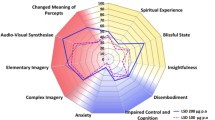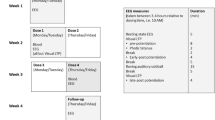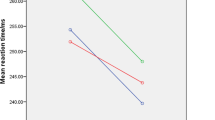Sensory and associative effects of LSD on classical appetitive conditioning of the rabbit jaw movement response (original) (raw)
Abstract
Three experiments were conducted to determine the effects of LSD (30 nmol/kg) in classical appetitive conditioning of the rabbit jaw movement response (JMR). In experiment 1, LSD significantly enhanced the acquisition of conditioned responses (CRs). The performance of control groups receiving unpaired presentations of the conditioned stimulus (CS) and unconditioned stimulus (UCS) demonstrated that LSD's enhancing effect on conditioning could not be attributed to an elevation in baseline responding, sensitization, or pseudoconditioning. Accordingly, experiments 2 and 3 were conducted to determine whether LSD's enhancement of conditioning could have arisen from its altering the sensory processing of either the CS or UCS, or botj. In experiment 2, LSD was found to have no significant effect on the functions relating UCS magnitude to the frequency, amplitude, or number of sinusoidal peaks comprising each unconditioned response (UCR). In contrast, experiment 3 revealed that LSD significantly enhanced the frequency of CRs to an extended range of CS intensities and lowered the CS intensity threshold. It was concluded that the enhancing effect of LSD on the acquisition of CRs is attributable, at least in part, to the drug's enhancement of the sensory processing of the CS.
Access this article
Subscribe and save
- Get 10 units per month
- Download Article/Chapter or eBook
- 1 Unit = 1 Article or 1 Chapter
- Cancel anytime Subscribe now
Buy Now
Price excludes VAT (USA)
Tax calculation will be finalised during checkout.
Instant access to the full article PDF.
Similar content being viewed by others

Modern Clinical Research on LSD
Article Open access 27 April 2017


Explore related subjects
Discover the latest articles and news from researchers in related subjects, suggested using machine learning.
References
- Burian H, Fleming W, Featherstone R (1958) Electroretinographic effects of LSD-25, brom-LSD, and LSM (lysergic acid morpholide). Fed Proc 17:355
Google Scholar - Cegavske CF, Thompson RF, Patterson MM, Gormezano I (1976) Mechanisms of efferent neuronal control of the reflex nictitating membrane response in rabbit (Oryctolagus cuniculus). J Comp Physiol Psychol 90:411–423
Google Scholar - Doty RW (1968) Alimentary canal: motility. In: Handbook of Physiology. American Physiological Society. Washington, DC, pp 1861–1902
Google Scholar - Gimpl MP, Gormezano I, Harvey JA (1978) Effects of LSD on learning as measured by classical conditioning of the rabbit nictitating membrane response. J Pharmacol Exp Ther 208:330–334
Google Scholar - Gormezano I (1966) Classical conditioning. In: Sidowski JB (ed) Experimental methods and instrumentation in psychology. McGraw-Hill, New York, pp 385–420
Google Scholar - Gormezano I (1972) Investigations of defense and reward conditioning in the rabbit. In: Black, AH, Prokasy WF, (eds) Classical conditioning II: Current research and theory. Appleton-Century-Crofts, New York, pp 151–181
Google Scholar - Gormezano I, Harvey JA (1978) Analysis of hallucinogens by means of Pavlovian conditioning. In: Stillman, R, Willette R, (eds) Psychopharmacology of hallucinogens. Pergamon Press, New York, pp 207–219
Google Scholar - Gormezano I, Harvey JA (1980) Sensory and associative effects of LSD in classical conditioning of the rabbit (Oryctolagus cuniculus) nictitating membrane response. J Comp Physiol (in press)
- Gormezano I, Kehoe EJ (1975) Classical conditioning: Some methodological conceptual issues. In: Estes WK (ed) Handbook of learning and cognitive processes. Conditioning and behavior theory, Vol. 2. Lawrence Erlbaum Associates, New Jersey, pp 143–179
Google Scholar - Gormezano I, Moore JW (1969) Classical conditioning. In: Marx MH (ed) Learning: Processes. MacMillan, New York, pp 121–203
Google Scholar - Grice GR (1968) Stimulus intensity and response evocation. Psychol Rev 75:359–374
Google Scholar - Grice GR (1972) Conditioning and a decision theory of response evocation. In: Bower GH (ed) Psychology of learning and motivation. Academic Press, New York
Google Scholar - Grice GR, Hunter JJ (1964) Stimulus intensity effects depend upon the type of experimental design. Psychol Rev 71:247–256
Google Scholar - Harvey JA, Gimpl MP, Gormezano I (1980) Effect of haloperidol and pimozide on learning as measured by classical conditioning of the rabbit nictitating membrane response. J Pharmacol Exp Ther (in press)
- Hull CL (1943) Principles of behavior. Appleton-Century-Crofts, New York
Google Scholar - Hull CL (1949) Stimulus intensity dynamism (V) and stimulus generalization. Psychol Rev 56:67–76
Google Scholar - Hull CL (1952) A behavior system. Yale University Press, New Haven
Google Scholar - Logan FA (1956) A note on stimulus intensity dynamism (V). Psychol Rev 63:63–73
Google Scholar - Mitchell DS, Gormezano I (1970) Water deprivation effects in classical appetitive conditioning of the rabbit's jaw movement response. Learn Motiv 1:199–206
Google Scholar - Moore JW, Goodell NA, Solomon PR (1976) Central cholinergic blockade by scopolamine and habituation, classical conditioning, and latent inhibition of the rabbit's nictitating membrane response. Physiol Psychol 4:395–399
Google Scholar - Perkins CC, Jr (1953) The relation between conditioned stimulus intensity and response strength. J Exp Psychol 46:225–231
Google Scholar - Poulos CX, Sheafor PJ, Gormezano I (1971) Classical appetitive conditioning of the rabbit's (Oryctolagus cuniculus) jaw-movement response with a single-alternation schedule. J Comp Physiol Psychol 75:231–238
Google Scholar - Purpura DP (1956) Electrophysiological analysis of psychotogenic drug action. I. Effect of LSD on specific afferent systems in the cat. Arch Neurol Psychiatry 75:122–131
Google Scholar - Razran G (1957) The dominance-contiguity theory of the acquisition of classical conditioning. Psychol Bull 54:1–46
Google Scholar - Scavio MJ, Gormezano I (1974) CS intensity effects on rabbit nictitating membrane conditioning, extinction and generalization. Pavlov J Biol Sci 9:25–34
Google Scholar - Smith MC, DiLollo V, Gormezano I (1966) Conditioned jaw movement in the rabbit. J Comp Physiol Psychol 62:479–483
Google Scholar - Winer BJ (1971) Statistical principles in experimental design. McGraw-Hill, New York
Google Scholar
Author information
Authors and Affiliations
- Departments of Psychology and Pharmacology, The University of Iowa, 52242, Iowa City, Iowa, USA
I. Gormezano, John A. Harvey & Ellen Aycock
Authors
- I. Gormezano
- John A. Harvey
- Ellen Aycock
Rights and permissions
About this article
Cite this article
Gormezano, I., Harvey, J.A. & Aycock, E. Sensory and associative effects of LSD on classical appetitive conditioning of the rabbit jaw movement response.Psychopharmacology 70, 137–143 (1980). https://doi.org/10.1007/BF00435304
- Received: 12 October 1979
- Accepted: 04 April 1980
- Issue Date: October 1980
- DOI: https://doi.org/10.1007/BF00435304